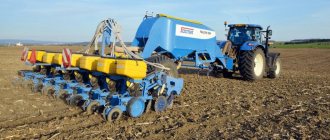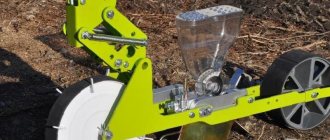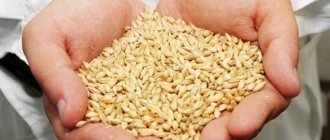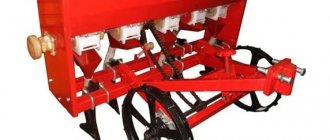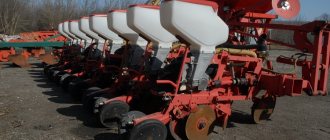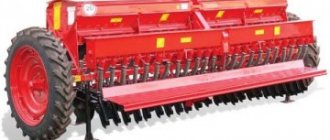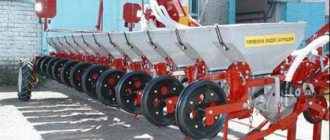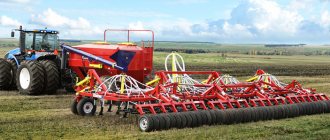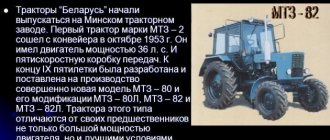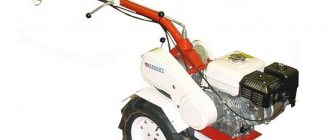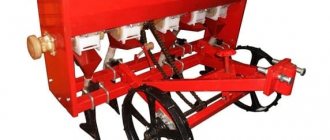Adding seed to the soil in an ordinary way is very convenient, but there is one drawback in the form of gaps. To prevent the growth of weeds, these bald spots are sown with green manure grasses, which improve the soil structure. Seeding equipment of the Ukrainian NWT series (Red Star) are distinguished by high quality and reliability, and make it possible to simultaneously introduce green manure and agricultural crops into the soil.
Why are lawn seeders needed?
Scattering grass seeds and at the same time fertilizing the soil with granules by hand is not very convenient.
After such sowing, you can observe how the grass grows unevenly, somewhere it is too thick, and somewhere it is not there at all. In some places you can see burnt areas, which means an overdose of fertilizer. Today, markets offer a huge number of different seeders, with which you can easily and evenly sow lawn grass, as well as scatter fertilizers. In such a unit, the sowing rate of seeds, sand, fertilizers and other granular materials is regulated.
That is, it can be used not only for sowing a lawn, but also for spreading sand and fertilizers or distributing drugs to protect plants from pests.
Different models of seeder-spreaders are equipped with different loading hopper volumes and have different working widths. According to the method of scattering, they are in-line, that is, the seeds are scattered in rows, and circular, in which there is a rotating element that scatters the seeds in a circle.
REVIEW OF TECHNICAL FEATURES OF SEEDERS FOR COMPLIANCE WITH NO-TILL TECHNOLOGY (DIRECT SOWING)
Direct sowing technology is a unique farming system in which sowing is carried out in unprepared soil, i.e. into soil that has not been subjected to any pre-treatment. In Russia, direct sowing is often also called zero technology or “no-till” (from the English “no-till” - do not plow).
In this work we will identify these concepts. The key ideological point of the technology is to minimize the external impact on the soil. The sowing itself is carried out with a special tool - a direct sowing seeder. With its help, a number of agrotechnical operations are carried out: cutting the soil and plant residues that are present on the field; fertilization; sowing seed material to a given depth; simultaneous sowing of a binary component – small-seeded crops; rolling the furrow and closing the furrow to create better seed-to-soil contact. Thus, direct seeding technology should be considered as a system consisting of many interrelated elements, each of which is very important and cannot be considered in isolation from the rest.
In countries with developed agriculture - such as the USA, Canada, Brazil, Argentina, Australia, and some countries of the European Union - direct seeding technology is a sign of farm quality and an indicator of effective resource conservation when growing major crops. An alternative to traditional plowing not only appeals to many farmers, direct seeding can simultaneously increase productivity and protect the environment.
Switching to direct seeding technology allows for more production at lower costs. Currently, this technology covers almost 170 million hectares in the world, of which 63 million hectares in North America, more than 60 million hectares in South America, 22.3 million hectares in Australia. The use of this technology in Russia is not yet so widespread. However, in the current economic conditions, this need is becoming more and more obvious for Russian farms. The commitment of domestic farmers to traditional technology is due to the established structure and favorable market conditions, when entry to foreign agricultural producers is practically closed.
New knowledge and experience of one of the founders of this farming system in Russia, Doctor of Agriculture. Sciences, Professor Nikolai Andreevich Zelensky are the basis for positive changes. In order to minimize the number of possible errors when switching to and working with Noutil technology, it is necessary to do serious preparatory work. It is recommended to visit farms that have already achieved results using the new technology. Online courses and webinars on the topic of direct sowing will also be useful (for example, this can be done on the Agrarum website at the link: www.agrarum.ru).
The development of direct seeding technology is inextricably linked with the development of plant protection products, the emergence of new fertilizers and the necessary seeders. In many ways, the history of the emergence of companies that are considered old-timers of direct seeding technology is based on economic premises. However, this was a forced transition. Since it was precisely the crisis phenomena in the economies of Latin American countries, which were faced with an acute shortage of energy resources, that led to the formation, in fact, of a state system of resource-saving agriculture. The rapid transition to knowill has made it possible to achieve significant success in the agricultural sector in these countries. This allowed us to take a leading position in the world in the field of agricultural production.
Carrying out a retrospective analysis, we can note that at the same time, the seeders of the traditional farming system served as the prototype of the first direct seeding seeders. Initially, no one developed a seeder specifically for zero technology. First there was a theory. Then practical methods began to develop. For a farmer who is just switching to a new farming system, versatility is more interesting. This gives you peace of mind that if things don't go according to plan, you can always return to traditional plowing. Therefore, seeders that can work using both traditional and new technology look like a more attractive farming tool in the eyes of such farmers. Another type of seeders - specialized seeders, designed for difficult conditions, were initially developed with a margin of safety and operation in the noutil system. They had to work in conditions of an uncultivated field, which means that other requirements were placed on them.
Today in Russia there is an acute issue of increasing agricultural productivity and the need to put fallow and waste land into circulation. At the state level, it is planned to introduce up to 12 million hectares of such land by 2030. Therefore, further we will talk about specialized seeders capable of working in the knowill system and introducing fallow fields. After all, they are the ones who are able to solve this seemingly complex and expensive task in the best possible way and with minimal effort.
In order to understand what requirements a modern seeder must meet, let’s consider the main components that ensure compliance with the technology.
The classic noutil seeder has two main organs.
- Openers (coulters) are devices that introduce seed into the soil.
- A dispenser that is responsible for adjusting seeding and maintaining set values throughout the entire sowing.
We can consider 2022 the year of formation of the Russian market of noutil seeders in the following system:
- Foreign manufacturers who have representative offices in Russia and/or have localized production. As a rule, such seeders are the most expensive and are available only to medium and large farms and holdings. Inflation and rising exchange rates of foreign currencies make such equipment, its components and consumables less accessible.
- Foreign manufacturers who do not supply seeders for direct sowing to the Russian market. This is due to the internal corporate policies of such companies, as well as existing trade restrictions and sanctions.
- Russian manufacturers who declare that their seeders comply with Noutil technology, but in fact they are converted traditional seeders. These are the cheapest seeders. However, it is after their use that many farmers become disillusioned with the technology, believing that it does not work as it should under the conditions of their particular farm. This thereby discredits all technology in Russia.
- Russian manufacturers who have managed to ensure that their seeders comply with Noutil technology and maintain production standards.
Understanding the variety of offerings requires some experience and understanding of how the technology works. Therefore, we will sequentially consider the types of seeders and the basic requirements imposed by the technology. The direct seed drill replaces most of the agricultural implements and techniques that are used in the traditional farming system - plowing, disking, cultivating and harrowing, etc. Consequently, these seeders have to withstand hard, uncultivated soil and still sow well. What unites all the seeders under consideration is that, within the framework of direct sowing technology, they must be able to perform at least three operations in one pass: create a seed bed in hard soil, sow seeds, apply mineral fertilizers and cover the furrow with high quality and, if necessary, perform binary sowing with small-seeded crops. This is the subject of the work and many years of experience of Prof. Zelensky N.A.
Figure 1 – Anchor opener
The first type of seeders is anchor seeders (Fig. 1.) They appeared at the dawn of knowill in the 70s of the 20th century in the USA. This appearance was due to the need to introduce seed into uncultivated soil. The main way to achieve this, at that time, was to place the seeder on a conventional cultivator. The cultivator made it possible to cut into uncultivated soil and sow, as if to till the soil a little, after which the seeds were laid behind it. Their subsequent development was aimed at reducing the cultivator foot, and in some cases, even their complete exclusion from the organ, i.e. Only the stand remained in order to reduce soil damage. The advantage of anchor seeders is that they can work in any farming system. They are easy to maintain and easy to use. A consumable can be an anchor that wears out or breaks when encountering an insurmountable obstacle in the field. The main disadvantage of such seeders is that they have a great impact on the soil and create a plow sole, which is not permissible with noutil. Currently, anchor drill manufacturers have reached their limit in optimizing the anchor or “claw”. The size of the paw has reached its limit and it is no longer possible to make it smaller (thinner). Consequently, the impact on the soil cannot be reduced any further.
Figure 2 – Disc seeders with coulter
The next type of seeders are disc seeders with a colter (Fig. 2.) These seeders appeared in the 80s in Latin America by installing a “cutting knife” in front of the traditional opener, which is also called a “turbo disc”, “turbo knife” or “coulter”. That is, in front of this ordinary classic coulter there is a cutting disc, like a cutting knife, which cuts a furrow and loosens the soil, and the coulter following it just needs to widen it and place the seed.
From its inception to the present day, many varieties of turbo discs have been developed: from a simple pointed disc to a wave-shaped one. Depending on the mechanical composition of the soil and its moisture content, a turbo knife is selected. Here lies the main weak point of disc seeders and the source of many of their problems. Since the quality of operation of such seeders significantly depends on soil moisture and a correctly selected coulter, there is a need to have several sets of such discs. Some discs work well in semi-dry soil, while others work well in wet soil. There is no golden mean. Therefore, it is necessary to re-equip the seeder whenever the humidity changes. For example, if it rained. Ideally, the farmer changes the discs twice a year, for spring and autumn sowing. But weather conditions can affect this seasonality. At the same time, disc seeders, especially their coulter units, are not suitable for quickly replacing disc with disc. This makes this technological operation difficult. In general, all disc seeders with coulters have less impact on the soil than anchor ones. The coupling assembly, consisting of a hub, disk and bearing, must have greater strength, since it experiences the greatest loads from the soil.
Figure 3 – Diffuse opener
The next type of seeders are seeders with a diffuse coulter (Fig. 3.) These seeders are a continuation of the development of disc seeders with a coulter, but in which the coulter was completely abandoned and the strength of the coulter was increased. The role of the coulter, in this case, was taken over by one of the opener discs. The diffuse coulter is a conventional two-disc coulter, similar to the coulter of the SZ-3.6 seeder, it is distinguished by greater strength and the fact that one of the discs is larger in diameter than the other. The larger diameter disc cuts the soil and creates a furrow. Here the diffuse vomer can be compared to a surgeon's scalpel. Like a surgical incision, it leaves a thin, neat groove. The impact on the soil is minimal. The angle at which the two discs are located is chosen so as to effectively cut the soil. Manufacturers strive to minimize this angle as much as possible. This affects two parametric characteristics, namely reducing the impact on the soil and the energy consumption of the seeder. In such conditions, it is easier for the coulter to cut through the soil, and it is easier for a tractor with such coulters to drag and operate the seeder. With a colter seeder, the disc runs in a straight line, so it is easier for it to cut through the soil than with a diffuse coulter. But on the other hand, this leads to the fact that there are many more planter organs in the soil. Thus, there are one and a half to two times more organs that create obstacles. All these organs can be a source of damage. Therefore, the costs of consumables increase proportionally. The bearing assembly is reinforced, so it is also more expensive than on coulter seeders. It should also be noted that coulter seeders and seeders with a diffuse coulter operate at speeds no higher than 8 km/h, since at higher speeds the seed material is captured by the discs of the coulter from the seed bed and thrown to the surface.
Figure 4 – Monodisc opener
The last type of seeders are monodisc seeders (Fig. 4). Here, it was not the disc harrow that was excluded from the unit, but the seeder coulter. The seed supply was brought to this disk unit. Thus, there is only one disk there. It goes at an angle, that is, it simultaneously cuts and creates a groove. It turns out something like an anchor foot. One part of the groove looks as if an anchor seeder went through there, and on the other side of the groove there is a disc seeder. The advantage of this device is the small number of components that can be a source of breakdowns and equipment failures. The foot does not wear off, it does not destroy the soil cover. The disk handles this task. The speed is higher than that of seeders with coulters and diffuse coulters. We also note that such seeders are less afraid of wet soil. At the same time, the mono-disc coulter damages the soil more than a coulter seeder.
The second main unit, which has been completely transferred from traditional seeders, is the sowing mechanism. According to this mechanism, seeders are divided into: mechanical and pneumatic.
Figure 5 – Mechanical seeder
Mechanical seeders (Fig. 5) are seeders in which seed dosing is carried out by a reel apparatus, and the seed material is fed under its own weight through seed tubes down to the coulter. The reel apparatus for mechanical seeders was created in the 50-60s. Since then, it has undergone a minimal number of changes, as it is as simple and reliable as possible. The existing changes were in the direction of reducing injury to the seed material (transition from metal to plastic).
In turn, mechanical seeders can be divided into several types according to the method of adjusting the seed sowing hole.
Mechanical seeders, with adjustment of the rotation speed of the coil in the device. This is realized by installing a variable gearbox or variator on the seeders. The advantages of this method are the possibility of a wide range of adjustment of the seed sowing rate and uniform wear of the coil and the body of the apparatus along the entire length. The disadvantages are: portioned seed ejection at low speeds and severe injury to seeds at high speeds of rotation of the coil; stepwise adjustment of the seeding rate on seeders with a variable gearbox; complexity and demandingness in servicing a variable gearbox or variator.
Mechanical seeders, with adjustment of the reel extension length by moving inside the device. The advantages of this method: simplicity of the design of the adjustment mechanism; optimal coil speed to eliminate portioning and injury to seeds. The disadvantages are: uneven wear of the coil and housing, as well as a small range for adjusting the seeding rate.
Combined mechanical seeders - when both previous methods are used simultaneously. The advantages of this method are: an optimal range of coil speeds to eliminate portioning and injury to seeds, a large range of adjustment of the seed sowing rate. The main disadvantage is the difficulty in setting the seeding rate.
The common advantages of all mechanical seeders are simplicity of design and maintenance, distribution of the weight of the seeds across the entire width of the seeder. The disadvantages are also known. The number of sowing units corresponds to the number of openers, which increases the number of consumables, low accuracy of seed placement, also limited dimensions of the seed hopper and the relatively small working width of the seeder (up to 10 m).
Figure 6 – Pneumatic seeder
Pneumatic seeding complexes and seeders (Fig. 6.) are seeders in which seed dosing is carried out by a reel apparatus of a different design, and the seed material is supplied to the coulters using compressed air. The advantages of pneumatic seeders are: one device in which settings are made; high precision of seed placement; the ability to create seeders with a large seed hopper and a large working width (more than 10 m). The disadvantages are: complexity of design and repair; The weight of the seeds in the hopper is usually concentrated closer to the center, which also leads to certain problems.
Thus, there are two main requirements for high-quality seeders:
- high-quality introduction of seed into solid soil to a given depth and its subsequent covering.
- minimal soil damage and impact.
Secondary requirements include:
- the ability to copy field unevenness (anthills, mole and mouse holes, etc.);
- maintainability and availability of components;
- Seeder energy consumption.
From these requirements it is clear that the noutil seeder must have a number of important characteristics (design features), which are as follows.
1. Heavy weight. A knowill seeder must be heavier than a seeder for a traditional farming system. This is necessary to ensure high-quality penetration of the coulters into the soil, so a light seeder will rise up regardless of the power of the clamping mechanism and the coulters will not be able to place the seed at the required depth. Also, the distribution of seed weight across the width of the seeder plays an important role. If the weight is concentrated in the center of the planter, this results in more force on the openers in the center than at the edges. If the weight of the seeds is evenly distributed across the entire width, then the force is also distributed evenly.
2. The presence of a powerful clamping mechanism. The clamping mechanism is a mechanism that creates a clamping force on the coulter to penetrate it into the soil and at the same time allow it to follow the topography of the field. The simplest clamping mechanism is springs, which create clamping force due to their rigidity. Changing the clamping force is done by changing the stiffness of the springs; there are many ways to do this. The advantages of this method: ease of design and repair; reduction of loads transmitted from the coulter to the seeder when moving over an uneven field. The disadvantages are the difficulty of adjusting the clamping force or their complete absence.
Since the force on the soil must be minimally sufficient to penetrate the coulter, and the soils, even in the same field, can be different, hydraulic and subsequently pneumatic clamping mechanisms were created. Instead of springs, such mechanisms use hydraulic cylinders or sometimes air springs. Thanks to their wide adjustment range, they allow you to create the required minimum force for cutting into the soil. The advantages are: easy adjustment of the force and creation of the minimum required pressure force; the ability to change the force for each coulter separately during operation of the seeder using sensors. Disadvantages: complex design and repair, especially if each section is controlled separately; increased demands on the tractor hydraulic system.
There are also combined clamping mechanisms of hydraulic cylinders and springs. In such a mechanism, the force on the coulter is created by springs, and their compression is regulated by a hydraulic cylinder. The advantages of this method: ease of design and repair than a purely hydraulic mechanism; reduction of loads transmitted from the coulter to the seeder when moving over an uneven field; easy adjustment of force. The disadvantages include the inability to change the force on each coulter separately during operation of the seeder.
3. Coulter mounting mechanism. Like the opener itself, this mechanism should be stronger than that of a traditional seeder. Structurally, there are two main types of such a hinge. The first type is the so-called pendulum type. (Fig. 7)
Figure 7 – Pendulum linkage
It is a beam with one axis of rotation and a pressure spring or hydraulic cylinder installed on top. The advantages of this type are simplicity of design, easy repairs and a small number of consumables. A seeder with this type of coulter replicates large uneven fields well, as it has a large working stroke. The disadvantage is that the coulter moves along a radius when copying field unevenness, which reduces the accuracy of seed placement. To reduce the curvature of the coulter movement, its beam is made longer, this leads to an increase in the dimensions of the seeder. The second type is a parallelogram. (Rice.
Figure 8 – Parallelogram linkage
The parallelogram design is more complex and consists of two cross beams and four pivot points, but it is more common. This is due to its parallelogram connection. The advantage of which is that the coulter moves when copying the soil vertically - up and down, which in turn increases the accuracy of sowing. Therefore, parallelogram placement is often used by seeders for row crops when it is necessary to place the seed at an equal distance between the seeds. Anchor coulters cannot work properly if they operate on a pendulum fastening. The advantages are the accuracy of seed sowing and small dimensions. The disadvantages include the complexity of design and repair due to the large number of rubbing pairs, as well as a relatively small working stroke when copying the surface.
4. The presence of support wheels, which provide control of the depth of seed placement and provide additional support. Seeders of traditional farming for the most part do not use support wheels on coulters, since they work on cultivated soil and the coulters in them are suspended, as it were. In seeders that comply with knowill technology, the load on the soil from the weight of the seeder is divided between the wheels of the seeder and the support wheels. This reduces soil compaction by the seeder. To ensure depth adjustment, the support wheels are equipped with a special adjustment mechanism, which makes the repair design more complex. On noutil seeders, flanges are sometimes used to control the depth of seed placement. The flanges are also a wheel that is installed on the axis of rotation of the disk. This is a simple design that does not require maintenance, but depth adjustment is only possible by replacing the flange with a flange with a different diameter. There is another option when rolling rollers or press wheels act as support. This makes it possible to simplify the design of the opener and reduce the number of components in it. Since the pressing wheels are located behind the coulter, the quality of following the field relief is reduced. It turns out that the coulter encountered an obstacle and passed it, but the wheel only reacted. In the case when the rolling wheels act as a depth limiter, they steal up to 1/3 of the force from the pressing mechanism.
5. Availability of pressing wheels. Press wheels are very important as they perform two functions: filling the furrow and compacting the soil above the seeds. There are several types of them, and the selection depends on the type of soil, like coulter discs. The development of press wheels continues.
6. The speed of coulters and seeders with a diphase coulter is limited to 8 km/h. Due to the design of the opener, to increase speed, a packer and press wheels are installed on the opener. Their task is to ensure uniform placement of seeds and reduce the release of seeds to the surface. Installing these elements allows you to increase the speed to 10-12 km/h on dry soil. However, with increasing humidity, the compactor rollers and packer worsen the situation with the ejection of seeds; dirt also sticks to them and they cease to perform their function.
7. Availability of markers. The big disadvantage of a marker is its impact on the soil, essentially disking at its location. A more correct approach to a resource-saving system is to install a navigator. It will be a universal device that can be used on other equipment, for example, on sprayers or a combine. Thus, the marker is an obsolete device that has a negative impact on the soil and which should also be monitored, especially when turning the seeder.
8. The seeder must have minimal pressure on the soil. This is achieved by increasing the width of the seeder, as well as increasing the pressure in the impellers.
9. Maintainability. Since various tools were excluded from direct sowing technology, the noutil seeder had to take advantage of manufacturability and absorb the necessary elements. The seeder took precisely the weight from the plow and harrow. The desire of some manufacturers to create specific components can negatively affect repairs in the field or even on the farm. How unified are these units, can they be found on the open market or can they only be found at the manufacturer or its representative offices. You should also pay attention to the material used to make a particular unit. For example, cast iron hubs. When destroyed, a cast iron part is almost impossible to restore. Therefore, it is important to have a larger number of relatively simple steel weldments. They are easier to restore. Steel parts are less durable, but they are easier to restore.
10. Consumables. They should be available and have analogues from other manufacturers. This is necessary so that you can use the seeder without wasting time while waiting for the original part. For example, each company makes discs that are used in a specific seeder, which is not entirely convenient when searching for spare parts. It is also desirable that the bearings be of a common model.
11. Volume of adjustments. Many people say that noutil seeders have many adjustments. However, the quality of sowing depends on the adjustments. The fewer adjustments a seeder has, the more likely it is that the seeder will not work as it should in your field. Thus, a small number of adjustments for a noutil seeder is rather a minus. Ergonomics is also important. However, the more convenient the adjustment, the higher the price. But you have a knot that you can conveniently adjust. There may be some adjustments that seem redundant now. However, they may be more useful in the future if the seeder contains them. This will allow you to avoid the need to modernize or purchase new necessary equipment.
12. High ground clearance. Ground clearance is especially important in the transport position. When a seeder is transported between fields, the higher the ground clearance, the more cross-country ability the seeder has. Along with the increase in ground clearance, the requirements for the strength and reliability of the entire transport system increase.
Thus, if the seeder meets the requirements stated above, then it will perform high-quality sowing using Noutil technology. It should be noted that the sowing process using noutil technology is fundamentally different from sowing using traditional technology and much depends on the motivation and knowledge of the machine operator.
The review was prepared by the team of authors:
Sukhinin N.V. - chief designer of Agrarum-tekhnika LLC,
Moshkin I.V. - Ph.D. in Economics, Executive Director of Profobrtekh LLC
Edited by Zelensky N.A., Doctor of Agricultural Sciences, Professor DSAU
The following sources and materials were used in preparing the review:
- Passport of the State program for the effective involvement of agricultural lands in circulation and the development of the reclamation complex of the Russian Federation, M. 2022.
- State Council, December 26, 2022, Patrushev Dmitry Nikolaevich, on the involvement of unused agricultural land in circulation / Transcript. [Electronic resource] Access mode: https://special.kremlin.ru/events/president/transcripts/62418, free (07/09/2020).
- Innovative technologies of direct sowing, M. 2019
- Portal "Agrarum" [Electronic resource] Access mode: www.agrarum.ru, free (09.10.2020).
- Economics of soil fertility conservation and agribusiness development // Moshkin I.V., Shurkin A.Yu., Babak Yu.V. / APK News. 2022. No. 11. pp. 88-91.
- Economic efficiency of no-till technology // Moshkin I.V., Shurkin A.Yu., Abramov A.A. / APK News. 2022. No. 5. P. 61-64.
Types of lawn seeders
Lawn seeders-spreaders are divided into manual, mechanical and professional units.
Manual lawn seeder . Manual devices for distributing grass and fertilizers consist of a hopper with a handle and are designed for sowing a small area with lawn. Most often, manual assistants are made of plastic and have a built-in distributor.
With the help of such a seeder, the amount of fertilizer poured out is controlled by changing the size of the hole in the bunker. To evenly distribute seeds and fertilizers throughout the area, simply rotate the handle.
Professional seeder . Professional units are used for sowing large areas, such as stadiums. Up to 100 kg of lawn grass seeds are loaded into their hopper. The working width reaches 2.5 meters. The sowing depth on this seeder can be adjusted manually.
Many mechanical professional seeders are equipped with a gasoline engine and move on four wheels. On the handle, which the operator holds, there are control levers. Such seeders are easily adjusted to different types of seeds. If you purchase additional equipment for them, they can easily serve as a scarifier.
Manual mechanical seeder
This type of device is suitable for owners of small and medium-sized plots of land. Using mechanical devices you can quickly and safely distribute:
Recent Entries
Chainsaw or electric saw - what to choose for the garden? 4 mistakes when growing tomatoes in pots that almost all housewives make Secrets of growing seedlings from the Japanese, who are very sensitive to the soil
- seeds;
- fertilizers;
- sand;
- salt;
- feed for birds and animals;
- stone chips;
- lime and much more.
Mechanical units are easy to use . It is enough to pour seeds or fertilizers into the hopper, then start pushing the seeder forward and scattering the grass by pressing the button.
However, mechanical seeders are not equipped with a device for covering the seeds with soil, so after sowing the lawn it is recommended to use a garden roller.
The most popular models of seeders
Garden supply stores have a wide range of seeders and spreaders from various manufacturers. The most popular models are:
Unit WE - B from the German manufacturer Wolf-Garden. It is equipped with a portable container with a dispenser, a spreading disc mechanism and batteries or an accumulator. The control keys are conveniently located on the handle of the model. One loading of seeds into the container will be enough to sow up to 750 m² of lawn grass. Seeds can be scattered at a distance of 0.5 to 2.5 m.
The Comfort 800 model from the German company GARDENA is a dotted type seeder. The unit is a two-wheeled cart with a hopper on the wheel axle and a handle. Uniform dispersion of seeds and fertilizers is ensured by a cylinder built into the hopper equipped with a scraper.
The capacity of the bunker ranges from 3 to 20 liters, and an area of 90–800 m2 can be sown with grass. The material is supplied by controlling the lever on the handle, and the seeding frequency is controlled by a precise dispenser. To prevent overlapping and overdosing, the units are equipped with a device for marking the sowing path.
The Texas company (Denmark) produces the CS 2500 seeder model , which is a two-wheeled cart with a handle. A hopper is installed on the axle of its wheels, equipped with a mechanical centrifugal spreading mechanism and a dispenser. The device control lever is located on its handle.
The operation of the mechanism is carried out due to the forward movement of the unit. You can load up to 22 kg of lawn seeds into the hopper and sow an area of 750 m². The maximum seed spreading width of this model is 2 meters. The unit weighs 10 kg.
NWT-3.6
The grain-grass seeder SZT-3.6 is equipped with a grass bunker and a bobbin sowing device and separate point coulters. This model can introduce agricultural crops into the soil along with green manure and mineral fertilizers simultaneously in 24 rows. It is also possible to use 3 sowing units in a row at once when using a special SP-11G hitch, but for operation you will need a tractor with a power of at least 150 hp.
Seeder device
The durable metal frame of the seeder is mounted on two support pneumatic wheels. Directly on the frame there are hoppers for seeding material of agricultural crops, herbs and mineral fertilizers, control and adjustment mechanisms. Pumping devices are mounted above the bunkers, and tedders are installed in the grain containers to prevent the seeds from sticking together.
To introduce agricultural crops, furrows in the soil are made with disc coulters, and for green manure, furrows are used that go into the soil to a shallower depth than the discs. The depth of penetration of the coulters into the soil can be changed using hydraulically driven markers.[/attention]
The supply of granular fertilizers is carried out by rearranging the corresponding valves, as a result of which the rotation speed of the sowing device shaft changes. The shaft of the fertilizer supply device has 6 gears, the green manure sowing device has 11, and the seed applicator has 4 gears.
Specifications
| Working grip, m. | 3,6 |
| Number of rows, pcs. | 24 |
| Distance between rows, mm. | 75-150 |
| Operating speed, km/h. | 9-12 |
| Productivity, m2/h. | 32 000-43 000 |
| Bunker for agricultural seeds, m3. | 0,453 |
| Bunker for green manure seeds, m3. | 0,086 |
| Bunker for fertilizers, m3. | 0,212 |
| Feed rate of grains or legumes, g/m2. | 1,5-40 |
| Green manure supply rate, g/m2. | 0,5-9 |
| Fertilizer supply rate, g/m2. | 2,5-20 |
| Dimensions d/w/h, mm. | 4 300х3 700х1 650 |
| Unit weight, kg. | 1 540 |
DIY seeder-spreader
In almost every house, there are unnecessary things lying around on the veranda or in the basement, with which you can make your own manual mechanical seeder. To make the device convenient, you need to prepare the following materials:
- Drive wheel.
- Opener with boards.
- Wheels (can be from a children's car).
- Metal strip.
- Bicycle sprockets - 2 pcs.
- An old canister.
- Bulgarian.
- Welding machine.
- Spanners.
With the help of such materials and tools, you can create a simple but very effective device for spreading lawn grass.

